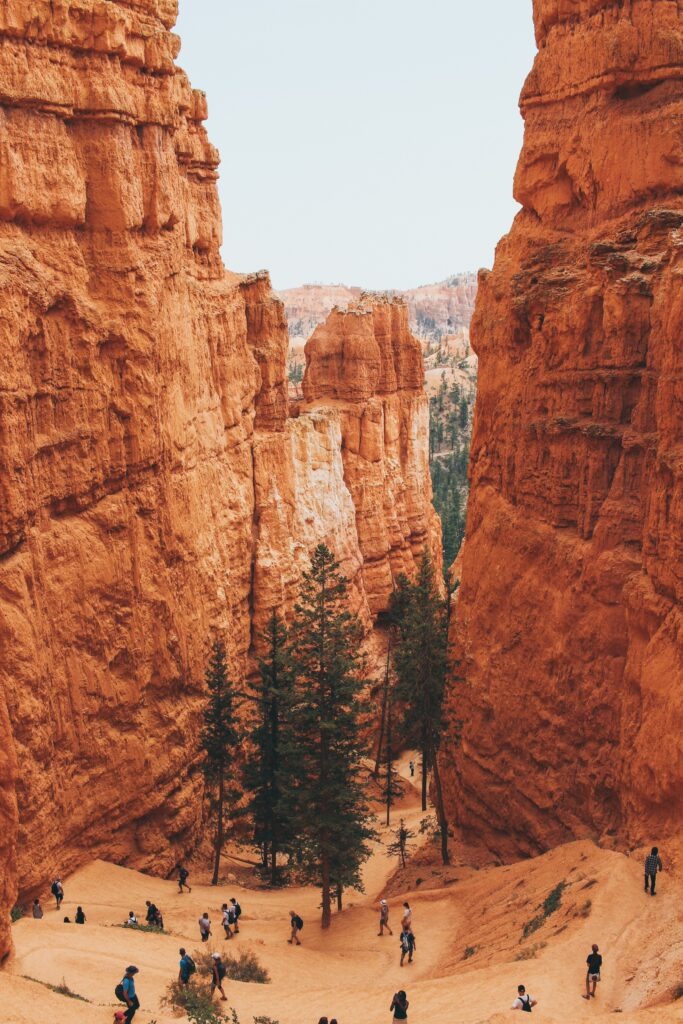Highlights: Bryce Canyon Hoodoos and Amphitheaters, Sunrise and Sunset Views, panoramic views, adventures, Natural Bridge, Stargazing, Navajo Loop Trail, Queens Garden Trail
Who: Everyone
What: Bryce Canyon, Southwestern Utah
Where: Located in the Colorado Plateau geographic province of North America
When: Summer Season (Late April to Early October: (8:00 AM- 8:00 PM).
Winter Season (Early October to Late April): The park’s hours may be reduced during winter.
Bryce Canyon, located in southwestern Utah, is one of the most under-explored national parks that will take your breath away. It covers the Colorado Plateau geographic province; interestingly enough, this is not a typical canyon! It is composed of remarkable formations called hoodoos, i.e., tall thin spires of rock reaching up to 200 feet in height, formed over the years due to erosion. The colorful red, orange, and white stones cover an area of 145 km2. While Bryce Canyon National Park provides a sight that no one can feel indifferent to, visitors can also enjoy a view of the Paunsaugunt plateau’s edge, looking over a valley containing numerous faults and the Paria River.
The largest area is Bryce Amphitheater (another term for hoodoo), with a length of 12 miles, while the highest point is Rainbow Point (9105 feet), offering breathtaking views.
As mentioned, there is not much information about the history of Bryce Canyon. What can be found is that this area was inhabited by The Paiute people. This southern civilization lived along the Colorado River. Therefore, most myths about this place are associated with them. One story says they believed hoodoos were the Legend People whom the trickster Coyote turned to stone. At least one older Paiute said his culture called the hoodoos Anka-ku-was-a-wits, which is Paiute for “red painted faces”.

Peak season ( May- September)
When it comes to the best time to visit Bryce Canyon, your choice is solely based on your preferences. Peak season typically starts in May and lasts until mid-September. During this period, you will enjoy pleasant mornings with a daily average temperature of 71.6 degrees Fahrenheit and a wide range of activities. Additionally, you can sign up for the Ultra Marathon in May if you like physical challenges, while those who believe in the destiny written in the stars can attend the Astrological Festival in June. The Geological Festival, or Geo Fest for short, is another event that takes place here in July, where you can join park rangers on hikes and feast your eyes on various kinds of beautiful rocks displayed at the Visitors Centre. Finally, a lot of traditional rodeos also take place during peak season – nothing too dangerous, just a family-friendly event with a local feel to it!
Although there may be crowds because of all these activities, there is a place for everyone in the park. However, if you choose to avoid the clamor, you may want to stray away from Bryce Canyon in the summer afternoons. Keep in mind, though, that it’s peak season after all, so sometimes, crowds may be unavoidable. Also, prices are obviously inflated during this time, so grab a few extra greens just in case.
October- April
Even though there were no organized activities during this period, Bryce Canyon National Park is still open to visitors, typically offering standard loop trail walks. You can explore the stones and paths covered with autumn leaves or snow. The daytime temperatures are pleasant (average temperature 50 degrees Fahrenheit), but the mornings are freezing. Enjoy the park without the crowds, and you can also visit the February Annual Winter Festival. It is the ideal period for your family trip and weekend nature walk; just make sure to dress warmly. Although the crowds are scarce, there are so many things to do in Bryce Canyon – even in winter!
You have already decided to visit Bryce Canyon – The next step is to explore vacation rentals near Bryce Canyon, but we’ll get more into that later. For now, let’s see how you can get to this fantastic place:
The most well-known hiking routes are Navajo Loop Trail and Queen Garden Trail. Both expeditions take two hours, are of moderate level, and can either be guided or done solo. Both tours are 0.9 miles and 1.3 miles long, respectively, leading to Sunset Point, one of Bryce Canyon’s most picturesque places. Although some experienced hikers travel the other way, going clockwise is advised. The Navajo Loop has some winter closures, while the Queen Garden route is usually always open. The bravest can do the combined three-hour, three-mile journey with intense difficulty. Stuck in the clockwise direction and direct to Two Bridges and Wall Street. Keep in mind that it can be closed in the winter.
Highlights of Queen Garden Trail: Queen Victoria Hoodoo, Sunset Point
Highlights of Navajo Loop Trail: Thor’s Hammer, Wall Street, Two Bridges
Extra tip: Proper hiking shoes are a must since the trails can sometimes get a bit challenging.
On the count of three, smile!
After discovering things to do in Bryce Canyon, you’ll need to choose a place to stay. We are here to make that process easier! On our website, you can find countless excellent vacation rentals close to Bryce Canyon. Explore some of our options, make your reservations, and have a fantastic time!
Your adventures shouldn’t stop after Bryce Canyon – check out the rest of our blogs for more travel inspiration!

STAY COPPER ROCK
1567 W Copper Rock Pkwy
Hurricane, UT 84737
435-352-1842
Please enter your username or email address. You will receive a link to create a new password via email.